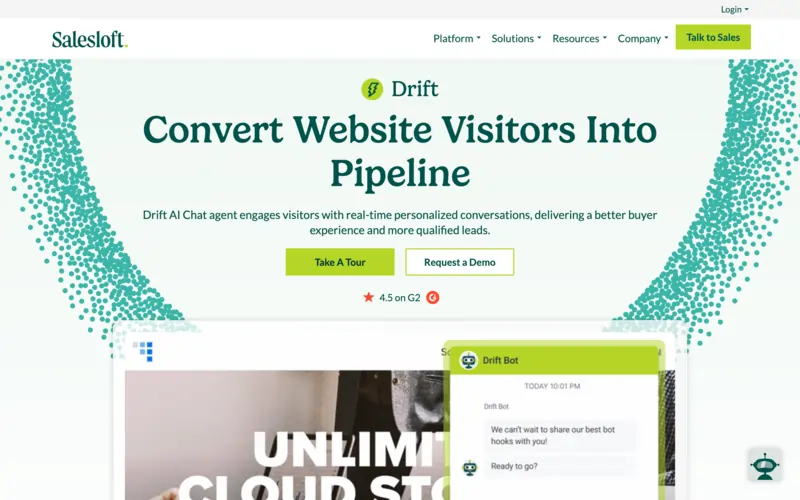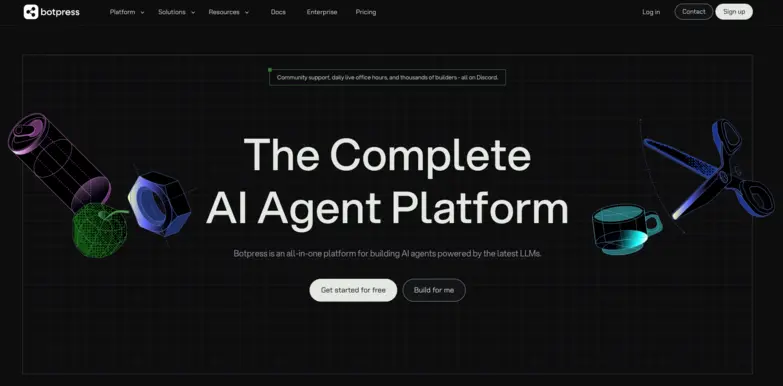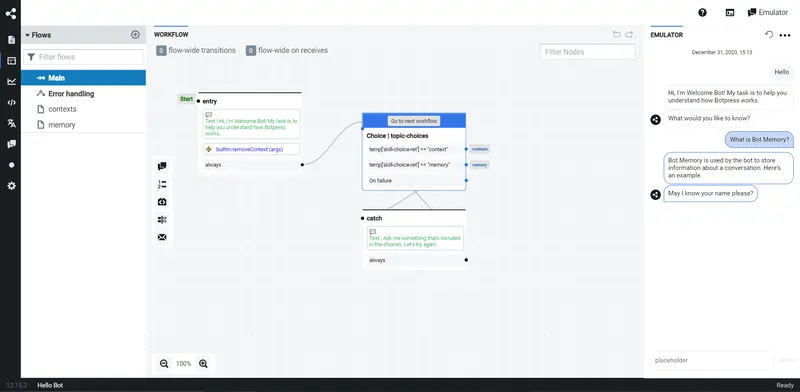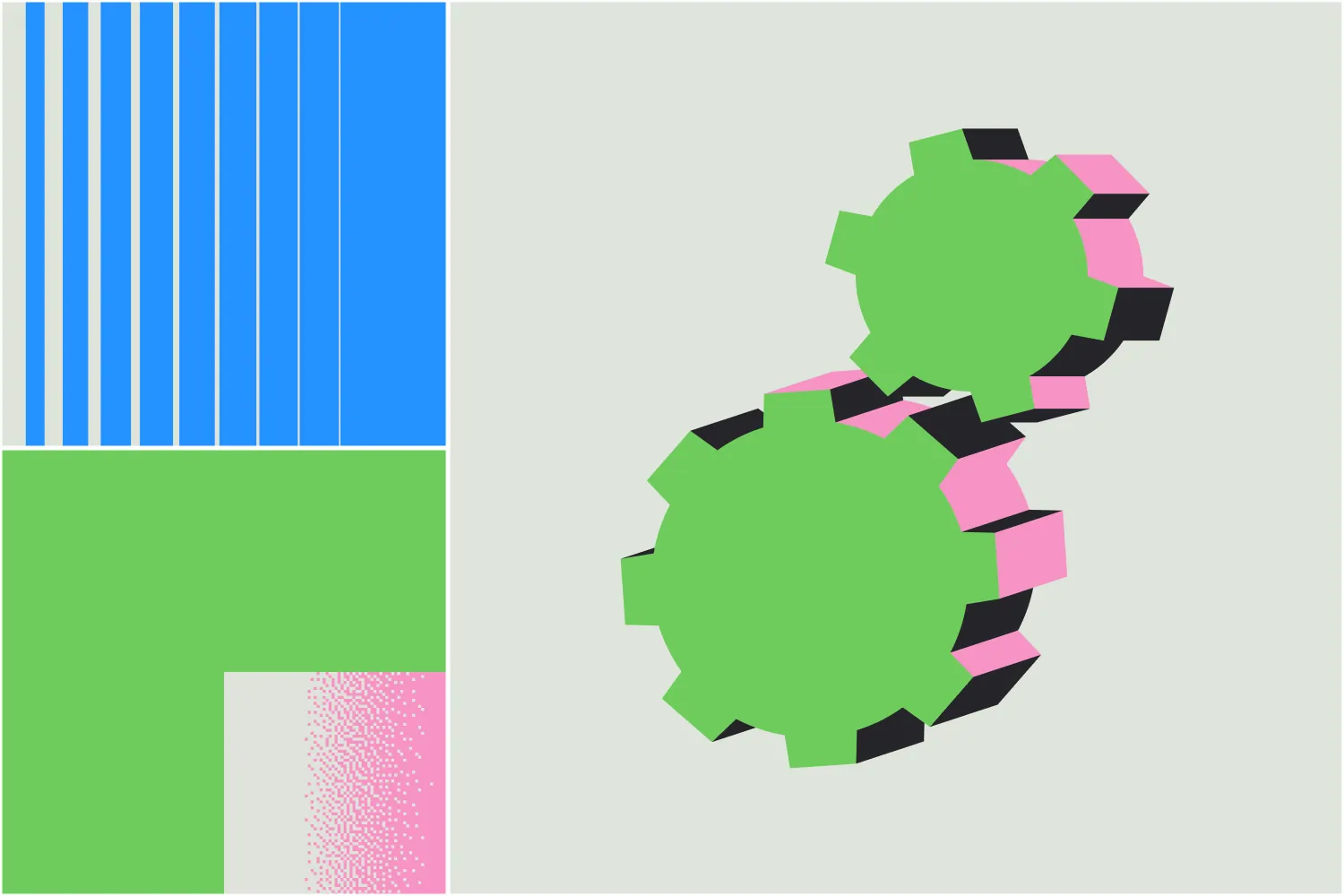The world of conversational AI is evolving fast, with dozens of platforms all claiming to be the top AI agent builders for modern businesses.The market is expected to grow from $17.05 billion in 2025 to $49.80 billion by 2031.
Whether you want an AI chatbot to resolve routine questions or a robust AI agent that can deliver truly personalized customer support at scale, choosing the right solution can feel like a maze.
Botpress and Drift both shine in the crowded landscape of conversational AI, but each caters to different business needs and technical expectations.
Curious how they compare when it comes to pricing, integration, automation, AI power, security, customization, and support? Let’s break down Botpress vs. Drift.
Quick Overview: Botpress vs. Drift
TL;DR: Both Drift and Botpress can create powerful AI agents, but the right choice depends on whether teams prioritize sales-focused automation or complete customization freedom.
Both Drift and Botpress enable organizations to develop robust conversational AI bots. The fundamental distinction between Drift and Botpress centers on their target audiences and whether they emphasize specialized functionality or maximum flexibility.
Drift is a conversational AI platform under Salesloft. They focus on offering customer service chatbots and sales chatbots that help automate lead qualification and improve digital customer experiences. Drift bots engage visitors in real time using firmographic data and route qualified leads to the right rep.

Botpress is a conversational AI chatbot platform designed to create sophisticated AI agents. With features like in-house retrieval-augmented generation (RAG) and multi-turn memory, Botpress enables the creation of AI agents that not only automate support but can drive product recommendations, onboarding, internal workflows, and more – all while being fully customizable.

Feature-By-Feature Comparison
Drift vs. Botpress Pricing Comparison
TL;DR: Drift is better suited for enterprises with large budgets, while Botpress makes powerful conversational AI accessible for smaller teams and businesses.
Drift’s AI capabilities are now part of the broader Salesloft platform, and pricing is no longer public. Instead, organizations must contact Salesloft for a customized quote.
Botpress offers a free plan that includes $5 in monthly AI credits. These AI credits act as a budget for powering smart features like knowledge retrieval and text rewriting in your bots.
Botpress also offers a Pay-As-You-Go option, which lets teams pay only for the AI usage they consume, making Botpress a cost-effective option for businesses.
In terms of paid plans, Botpress offers straightforward pricing tiers:
Integration Capabilities
TL;DR: Drift supports 46+ integrations tailored to sales and marketing workflows. Botpress offers 190+ integrations across categories and allows full control for building custom connections.
Drift comes with 46+ pre-built integrations focused on CRM, sales, and marketing ecosystems. Key native integrations include Salesforce, HubSpot, Marketo, Outreach, and Google Calendar. Drift also integrates with Salesloft's broader platform. Drift also offers APIs for advanced use cases, but building deep backend logic requires engineering effort and is constrained by the platform’s sales-focused use case.
Botpress supports 190+ pre-built integrations across CRMs, help desks, e-commerce platforms, data tools, and communication channels. These include native support for platforms like Zendesk, Shopify, Salesforce, and Twilio.
Botpress also enables developers to build custom integrations directly within the platform using API calls and JavaScript/TypeScript-based nodes. This allows businesses to connect bots to internal systems or third-party apps without relying on external middleware, making Botpress flexible for use cases beyond sales.
Use Cases
TL;DR: Drift is focused on conversational sales and marketing, while Botpress can be used for any business process automation.
Drift is purpose-built for revenue teams. It specializes in conversational marketing and sales automation, helping companies bring AI lead generation and AI sales funnels to fruition. Drift bots are commonly used on company websites to greet visitors, route conversations to sales reps, and integrate with CRMs like Salesforce and HubSpot. While powerful for top-of-funnel sales workflows, Drift isn’t built for broader business process automation or backend logic beyond the sales stack.
Botpress is a general-purpose conversational AI platform, though it can also support conversational marketing and sales automation. It supports use cases beyond customer acquisition, such as customer support, employee onboarding, IT helpdesk automation, HR queries, logistics tracking, and more. Ultimately, Botpress allows for teams to automate complex workflows across departments.
Security Features
Knowledge Capabilities
TL;DR: Drift relies on existing content and FAQs to power conversational bots, while Botpress delivers broader flexibility by connecting to APIs & databases, and employing retrieval-augmented generation.
Drift leverages existing help center articles (e.g., in Zendesk or Drift’s Knowledge Base) to provide automated answers. Bots can surface pre-defined content and FAQs based on user intent.
While Drift offers filters to guide users to relevant articles, it doesn’t support live data connections or flexible data retrieval. Content must be prewritten and stored in approved formats; there’s no built-in support for crawling documents, calling APIs, or generating answers on the fly.
Botpress supports an advanced approach to knowledge access. In addition to importing static content like FAQs and documents, Botpress allows bots to connect to APIs, query databases, or parse structured and unstructured data such as JSON, CSVs, PDFs, or even web-scraped content.
Botpress’ in-house retrieval-augmented generation engine enables bots to extract the most relevant information at runtime, and generate contextualized responses based on retrieved content. This allows teams to build bots that don’t just recite static answers but adapt to varied user questions and contexts.
Customization & Flexibility
TL;DR: Botpress gives teams full control over custom logic and integrations. Drift offers preset playbooks and API access, but with limited room for customization.
Drift lets teams build chat logic using its visual playbook editor: deciding conversation branches, routing, and lead qualification.
While Drift enables interactions via playbooks and GPT-style replies, it doesn’t support custom scripting or internal logic beyond predefined flows. Developers can integrate with external systems using REST APIs or webhooks, and there’s a public API and SDK for building custom apps, but all business logic must live outside the chat platform itself, not within Drift.
.webp)
Botpress is built for full-stack customization. Developers can write JavaScript or TypeScript directly in the platform to design conversation flows, call APIs, run scripts, and handle dynamic logic.
Botpress also supports reusable components, conditional logic, and full widget customization. Everything from messaging behavior to NLP tuning and UI appearance can be controlled within a single environment – perfect for building custom agents.

Memory Duration
TL;DR: Drift does not include persistent memory across sessions. Botpress provides built-in memory, enabling chatbots to remember users and personalize conversations over time.
Drift does not offer native long-term memory within its chatbot platform. It can collect user data (e.g., email, company, conversation history) during a single interaction and sync it to connected CRMs like Salesforce or HubSpot.
However, Drift bots themselves do not retain memory across sessions. Any personalization or context continuity must come from CRM fields or external tools, not directly from the bot's internal logic.
Botpress includes robust, built-in memory that works across conversations. Bots can store and retrieve user details – like preferences or prior questions – without requiring external storage. Developers can customize what gets remembered, for how long, and how it's used in future sessions, resulting in greater personalization for customers.
Community & Support
TL;DR: Drift provides structured support and onboarding geared toward sales teams, while Botpress combines strong developer support, live assistance, and an active open-source community.
At a baseline, both Drift and Botpress offer learning resources including documentation, help centers, and onboarding guides.
Drift provides in-app documentation, an online Help Center, and email-based support. Higher-tier customers can access premium support options, including onboarding services and dedicated Customer Success Managers.
However, Drift does not offer an open developer community or self-hosted peer support channels. Its resources are designed to assist revenue teams and sales operations, rather than technical teams customizing bots deeply.
Botpress, on the other hand, supports developers at every stage:
- Live Chat Support is included with Plus plans and above
- Max, the AI Support Bot, gives real-time help and documentation lookup
- Customer Success Managers are available for Team and Enterprise customers
- A 30,000+ member Discord server hosts peer Q&A, feature discussion, and daily AMAs with the Botpress team
While Drift’s support is well-suited to sales-oriented users, Botpress is built to empower developer teams with both real-time and community-driven help.
Which platform is better for my business?
1. 24/7 Multilingual Support for a Global Travel Company
Key Problem: Providing 24/7 multilingual support across channels for a global customer base.
TL;DR: Drift supports multilingual messaging for sales and customer interactions but lacks deep NLP or memory features. Botpress offers stronger multilingual NLP and channel flexibility.
Amir leads customer support at a global travel booking platform. His team deals with time-sensitive inquiries like flight changes, cancellations, and travel advisories – often in multiple languages and across channels like WhatsApp, mobile apps, and the company website. Amir needs:
- A chatbot that can understand and respond in multiple languages
- Consistent experience across all platforms
- Ability to access real-time booking data and perform actions like cancellations or itinerary changes
Drift supports basic multilingual chat (20+ languages) with manual configuration of translated content. While you can create versions of bot flows in different languages, Drift does not offer native multilingual NLP or automatic language detection. It integrates primarily with website chat and email, and focuses heavily on routing visitors to sales reps. It lacks persistent memory and depends on external CRMs for storing user context, which limits personalized experiences across sessions.
Botpress offers robust multilingual support (100+ languages) with advanced NLP and localization controls. It allows teams to build flows that adjust based on user language, region, or booking history. Bots can connect across platforms like WhatsApp, web, and mobile, and retain user preferences between sessions to support truly personalized travel conversations.
For travel teams requiring multilingual NLP and personalized conversations, Botpress is the more scalable and adaptable solution.
2. Subscription SaaS Customer Support Scaling
Key Problem: A fast-growing SaaS company wants to deflect basic technical support and billing inquiries without hiring more agents.
TL;DR: Drift is built for sales handoffs and lead routing, not deep customer support. Botpress provides backend integrations, memory, and support automation for SaaS teams.
Sam is the Head of Support at a rapidly growing B2B SaaS company. His team handles a flood of tickets related to login issues, billing confusion, and onboarding questions. To keep up without hiring more agents, Sam needs:
- A chatbot that can answer repetitive technical and billing questions
- Easy deployment within Zendesk and Intercom workflows
- Backend integration with CRM and billing systems like Stripe or HubSpot
Drift can handle basic pre-sales questions, triage users, and schedule demos. Sam could use Drift for routing issues to agents or flagging common topics, but there's no native memory or complex logic. Integrations with CRMs like HubSpot help with qualification, but it won’t pull data from tools like Stripe or manage ticket resolution.
Botpress lets Sam build bots that answer account, billing, and onboarding questions using real-time APIs. With persistent memory and reusable flows, bots can troubleshoot login problems, check payment statuses, and trigger CRM or email automations—without agent intervention. Botpress also fits into workflows in Zendesk, Intercom, or Slack.
For fast-scaling SaaS teams needing more than handoffs, Botpress delivers deeper support automation and backend flexibility.
3. Automated Order Management for a D2C E-commerce Brand
Key Problem: Automating post-purchase support like tracking, returns, and product questions.
TL;DR: Drift is geared toward lead capture and product discovery, while Botpress supports full post-purchase automation and personalization.
Priya leads CX at a D2C e-commerce brand that just expanded internationally. Her team handles thousands of queries about order tracking, returns, and product details every week. Priya needs:
- A chatbot that can guide customers through returns and track orders in real time
- Seamless integration into Shopify and web chat
- Support for automating repetitive tasks like refund requests or FAQs
Drift works well for pre-purchase questions like recommending products or routing to sales, but it doesn’t support automated workflows for returns, order lookups, or post-purchase troubleshooting. It lacks native Shopify integration and session memory, so every user interaction starts fresh.
Botpress integrates directly with Shopify and similar platforms to check order statuses, initiate returns, and walk users through refund processes. It supports product catalog filtering using natural language and can remember preferences from previous chats to personalize recommendations or reorders.
For D2C teams automating post-sale interactions and workflows, Botpress provides the automation depth Drift does not.
4. Heavily Regulated Industry Support (e.g. Healthcare)
Key Problem: Automating inquiries while meeting strict compliance and audit needs.
TL;DR: Drift lacks native compliance features or data control. Botpress offers built-in audit logs, on-premise deployment, and secure memory for sensitive industries.
Marcus is responsible for customer experience at a healthcare provider. His team wants to automate scheduling, policy questions, and coverage info while staying compliant with HIPAA and regional data laws. Marcus needs:
- A secure chatbot that protects patient data
- Full audit logs and access control
- Option to deploy on-premise for compliance with internal security policies
Drift is designed for outbound engagement and does not offer HIPAA compliance, RBAC, or audit trails. Marcus’s team would need to manage security via third-party integrations and could not host the platform privately. Persistent memory and sensitive data handling would be offloaded to external tools with limited safeguards.
Botpress supports on-premise and private cloud deployment, encrypted memory, and full audit logs. Marcus’s developers can build secure workflows – like checking insurance eligibility or appointment scheduling – entirely within a compliant environment. Botpress also supports custom data retention rules, making it easier to meet GDPR requirements.
For regulated industries that require compliance, Botpress is purpose-built to meet enterprise standards.
The Bottom Line: Botpress vs Drift
Drift and Botpress are both powerful platforms for building AI agents but they’re optimized for very different goals.
Drift is best for go-to-market teams looking to drive revenue through conversational sales and marketing. Its platform is purpose-built for lead qualification and sales pipeline acceleration. Ultimately, Drift excels when it comes to customer service and sales AI but offers limited flexibility for broader automation use cases.
Botpress is designed for teams building highly customizable conversational AI agents. It offers full control over logic, memory, integrations, and UI – ideal for businesses that need to automate complex workflows beyond just sales.
FAQs
1. Can Botpress handle both pre-sales conversations and operational workflows in one agent?
Yes, Botpress can handle both pre-sales conversations and operational workflows within a single agent. Its modular architecture and built-in memory allow the bot to switch between tasks like lead qualification, product recommendations, internal ticketing, or HR automation without losing context or requiring separate bots.
2. How do platform philosophies (plug-and-play vs. open customization) impact long-term chatbot performance?
Plug-and-play platforms like Drift are faster to launch but can become limiting as business needs grow, since customization is restricted to preset templates and external APIs. Open customization platforms like Botpress offer more development overhead initially but scale better long-term by allowing full control over behavior, integrations, memory, and logic.
3. What technical skills are needed to build custom logic in Botpress vs. Drift?
To build custom logic in Botpress, developers should know JavaScript or TypeScript, as the platform supports in-platform scripting and code nodes. In contrast, Drift relies on predefined playbooks and external APIs, so custom logic typically requires API configuration knowledge and backend development outside the Drift environment.
4. Can either platform support AI-generated responses based on real-time CRM or ERP data?
Yes, both platforms can support AI-generated responses using CRM or ERP data, but Botpress does it natively. Botpress allows in-flow API calls and real-time data fetching from systems like Salesforce or SAP, enabling dynamic responses. Drift requires external middleware or backend services to achieve similar functionality, which increases integration complexity.
5. How do Drift’s predefined playbooks compare to Botpress’s visual flow builder in terms of flexibility?
Drift’s predefined playbooks are designed for linear sales and support flows, with limited logic branching and no in-platform scripting. Botpress’s visual flow builder is flexible – it supports conditional logic, context variables, API calls, and custom scripting, making it suitable for complex, adaptive conversations beyond just lead routing.





.webp)

